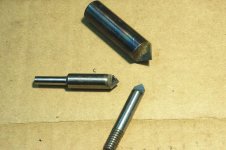Hi,
I have some broken Chinese machinery made of cheese that I have to get functional by tuesday morning. I have to countersink (M5 din 7991 bolt. About 1/4 allen head machine screw) two dozen holes that are inaccessible with anything less than 4 " shank to very mild and chewed up steel.
I was going to take a 10 mm (5/8) HSS drill bit and single flute grind it and peck away. Is this viable? Or would I have better luck with keeping both flutes? I don't want to break a bit in there unless it's just a calculated risk.
I wouldn't really know what to look for in the grind. Not really my area of expertise.
I'm in Finland; nothing's open until it's too late, and finding a long shank countersink won't be easy anyway.
Any pointers would be appreciated. Google didn't seem to help.
With regards,
Jon
I have some broken Chinese machinery made of cheese that I have to get functional by tuesday morning. I have to countersink (M5 din 7991 bolt. About 1/4 allen head machine screw) two dozen holes that are inaccessible with anything less than 4 " shank to very mild and chewed up steel.
I was going to take a 10 mm (5/8) HSS drill bit and single flute grind it and peck away. Is this viable? Or would I have better luck with keeping both flutes? I don't want to break a bit in there unless it's just a calculated risk.
I wouldn't really know what to look for in the grind. Not really my area of expertise.
I'm in Finland; nothing's open until it's too late, and finding a long shank countersink won't be easy anyway.
Any pointers would be appreciated. Google didn't seem to help.
With regards,
Jon



